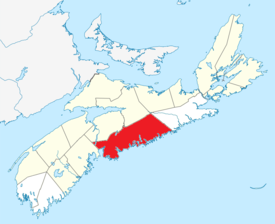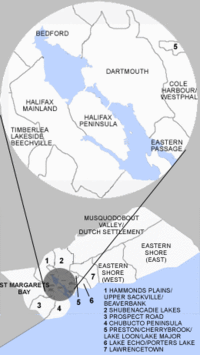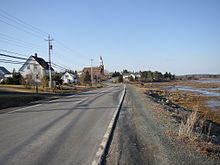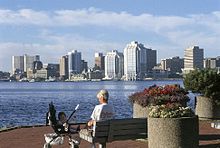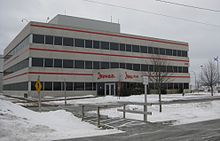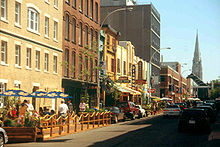- Halifax Regional Municipality
-
Halifax — Regional Municipality — Halifax Regional Municipality Top - Halifax Skyline, Middle left - Citadel Hill, Bottom left - Metro Transit Ferry, Right - Halifax Town Clock 
Flag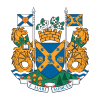
Coat of arms
LogoMotto: "E Mari Merces" (Latin)
"From the Sea, Wealth"Location of Halifax Regional Municipality Coordinates: 44°51′16″N 63°11′57″W / 44.85444°N 63.19917°WCoordinates: 44°51′16″N 63°11′57″W / 44.85444°N 63.19917°W Country Canada Province Nova Scotia Established April 1, 1996 Government – Type Regional Municipality – Mayor Peter Kelly – Governing body Halifax Regional Council – MPs List of MPs– MLAs List of MLAsArea[1] – Land 5,490.18 km2 (2,119.8 sq mi) – Urban 262.65 km2 (101.4 sq mi) – Rural 5,528.25 km2 (2,134.5 sq mi) Highest elevation 145 m (475.6 ft) Lowest elevation 0 m (0 ft) Population (2006)[1] – Regional Municipality 372,679 (13th) – Density 67.9/km2 (175.9/sq mi) – Urban 290,742 – Urban density 1,077.2/km2 (2,789.9/sq mi) – Metro 372,858 (13th) – Change 2001-06  3.8%
3.8%– Census Ranking 13 of 5,008 Demonym Haligonian Time zone AST (UTC−4) – Summer (DST) ADT (UTC−3) Area code(s) 902 Dwellings 166,675 Median Income* $54,129 CDN Total Coastline 400 km (250 mi) NTS Map 011D13 GNBC Code CBUCG Website www.halifax.ca *Median household income, 2005 (all households) Halifax Regional Municipality (
 /ˈhælɨfæks/; commonly Halifax or HRM) is the capital of the province of Nova Scotia, Canada. The Regional Municipality had a 2006 census population of 372,679,[2] while the metropolitan area had a 2010 estimated population of 403,188,[3][4] and the urban area of Halifax had a population of 282,924.[5] Halifax is the largest population centre in Atlantic Canada and largest in Canada east of Quebec City.
/ˈhælɨfæks/; commonly Halifax or HRM) is the capital of the province of Nova Scotia, Canada. The Regional Municipality had a 2006 census population of 372,679,[2] while the metropolitan area had a 2010 estimated population of 403,188,[3][4] and the urban area of Halifax had a population of 282,924.[5] Halifax is the largest population centre in Atlantic Canada and largest in Canada east of Quebec City.Halifax is a major economic centre in eastern Canada with a large concentration of government services and private sector companies. Major employers and economic generators include the Department of National Defence, various levels of government, and the Port of Halifax. Agriculture, fishing, mining, forestry and natural gas extraction are major resource industries found in the rural areas of HRM.
Contents
History
Further information: History of the Halifax Regional Municipality and Timeline of Halifax historyThe area comprising present day Halifax County was settled for thousands of years by the Mi'kmaq. Those who settled on Halifax Harbour called it Jipugtug (anglicised as "Chebucto"), meaning Great Harbour. The first permanent European settlement in the area was the establishment of the Town of Halifax, named after the British Earl of Halifax, in 1749 when the colonial capital was transferred from Annapolis Royal; other towns and villages were established throughout adjacent areas of what would become Halifax County in the decades that followed. The British founding of Halifax initiated Father Le Loutre's War and the capital region was raided during the war 13 times by the Acadians and Mi'kmaq.
In 1996 the provincial government amalgamated all municipal governments within Halifax County to create HRM, a regional municipality comprising approximately 200 individual communities or placenames for civic addressing grouped into eighteen planning areas for zoning purposes.
Geography
Main article: Geography of the Halifax Regional MunicipalityThe Halifax Regional Municipality occupies an area of 5,577 square kilometres (2,353 sq mi),[6] (approximately 10% of Nova Scotia) comparable to the province of Prince Edward Island, and measures approximately 165 kilometres (102.5 mi) in length between its eastern and western-most extremities, not including Sable Island. The nearest point of land to Sable Island is not actually in HRM, but rather in adjacent Guysborough county, however, Sable Island is considered part of District 13 in HRM.
The coastline is heavily indented, accounting for its length of approximately 400 kilometres (250 mi), with the northern boundary usually being between 50-60 kilometres (30-37 mi) inland. The coast is mostly rock with small isolated sand beaches in sheltered bays. The largest bays include St. Margarets Bay, Halifax Harbour/Bedford Basin, Cole Harbour, Musquodoboit Harbour, Jeddore Harbour, Ship Harbour, Sheet Harbour, and Ecum Secum Harbour. The municipality's topography spans from lush farmland in the Musquodoboit Valley to rocky and heavily forested rolling hills.
Urban-rural characteristics
Main article: Halifax Urban Area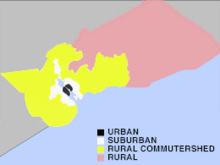 Urban, Suburban, Rural divisions of HRM as defined by HRM Planning Department http://www.halifax.ca/regionalplanning/Images/HRMmaplg.jpg
Urban, Suburban, Rural divisions of HRM as defined by HRM Planning Department http://www.halifax.ca/regionalplanning/Images/HRMmaplg.jpg
 The flag used by the former City of Halifax from July 1, 1992, until its dissolution and merger on April 1, 1996
The flag used by the former City of Halifax from July 1, 1992, until its dissolution and merger on April 1, 1996
The municipality is centred on the urban core and surrounded by areas of decreasing density the farther the community is from the core.
Unlike most municipalities with a sizable census metropolitan area, Halifax Regional Municipality's suburbs have been completely incorporated into the entire municipality (often by referendum. For example, the community of Spryfield, in the Mainland South area, voted to amalgamate with Halifax in 1968), with the urban area including the urban core, suburban communities and a rural commuter shed that encompasses almost half the municipality's landmass.
The urban area of HRM (2006 pop: 282,924)[5] is located in the western end of the municipality, fronting on Halifax Harbour. The dense urban core is centred on the Halifax Peninsula and the area of Dartmouth inside of the Circumferential Highway. The suburban area stretches beyond Mainland Halifax to the west, Cole Harbour to the east, and Bedford, Lower Sackville and Windsor Junction areas to the north.[7]
This urban area constitutes the most populous urban area on Canada's Atlantic coast, and the second largest coastal population centre in the country, after Vancouver, British Columbia. HRM currently accounts for 40% of Nova Scotia's population, and 15% of that of Atlantic Canada.
The north eastern area centred on Sheet Harbour and the Musquodoboit Valley is completely rural, with more in common with adjacent rural areas of neighbouring counties.
HRM's boundary includes all of Halifax County except for several First Nation reserves. Statistics Canada identifies HRM as a census subdivision while Halifax County is listed as a census division, despite the fact that both geographic areas differ by only several dozen hectares. Statistics Canada also lists the dissolved municipalities of Bedford, Dartmouth and Halifax, describing them as "Dissolved (municipalities) having undergone an amalgamation/dissolution)."[8]
Neighbourhoods and communities
Main article: Communities in the Halifax Regional MunicipalityThe Halifax Regional Municipality is an amalgamation of four municipal governments in the urban and rural areas, therefore its composition of neighbourhoods and communities is unlike other municipalities such as a city.
There are over 200[9] official rural and urban communities within Halifax County that have maintained their original geographic names (including the dissolved cities of Halifax and Dartmouth and the town of Bedford). These community names are used on survey and mapping documents, for 9-1-1 service, municipal planning, and postal service.
HRM is divided into eighteen community planning areas which are further divided into neighbourhoods or villages.[10] Several communities or neighbourhoods that were amalgamated by the former constituent municipalities in previous decades are starting to see their names gain increased use.[citation needed] The regional municipality has taken steps to reduce duplicate street names for its 9-1-1 emergency dispatch services; at the time of amalgamation, some street names were duplicated several times throughout HRM.[11]
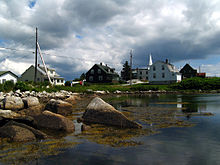 Community of Prospect
Community of Prospect
The urban core of HRM is a term used to roughly describe the urban concentration surrounding Halifax Harbour in the western part of the municipality, and includes the Halifax Metropolitan Area, the Dartmouth Metropolitan Area, and the Bedford-Sackville areas. Rural areas lie to the east, west and north of this urban core. Certain rural communities on the urban fringe function as suburban or exurban areas, with the majority of those residents working in the urban core. Farther away, rural communities in HRM function much as any resource-based area in Nova Scotia, being sparsely populated, with their local economies developing around four major resource industries: agriculture, fishing, mining and forestry. It should be noted that the tourism industry is beginning to change how some rural communities in HRM function, particularly in coastal areas such as Hubbards, Peggys Cove and Lawrencetown.
Climate
Despite its coastal location, the climate of HRM is humid continental (Köppen Dfb), due to the prevailing westerly winds blowing from the mainland of the continent. HRM's climate is, however, heavily influenced by its location on Nova Scotia's Atlantic coast. The weather is usually milder or cooler than that of central Canada, with the temperature remaining (with occasional notable exceptions) between about −15 °C and 25 °C (5 °F to 77 °F) inland. Coastal sections have even less range due to strong maritime influence. Precipitation is high year-round; snow, rain and ice mixes are common in the winter, though sometimes it is mild and rainy. Halifax often receives tropical storms, mostly between August and October. They are very rarely at hurricane force when they make landfall, the most recent exception being when Hurricane Juan, a Category 2 storm, hit in September 2003, and Hurricane Earl which grazed the coast as a Category 1 storm in 2010. Atlantic sea surface temperatures off the coast of Nova Scotia were warmer than normal those years, and the accelerated storm tracks did not allow for the weakening that usually occurs with hurricanes moving over the colder waters of the Nova Scotia coast after passing the Gulf Stream.
Climate data for Halifax, Nova Scotia (Halifax Citadel, 1971−2000) Month Jan Feb Mar Apr May Jun Jul Aug Sep Oct Nov Dec Year Record high °C (°F) 14.0
(57.2)16.0
(60.8)23.5
(74.3)26.1
(79.0)33.3
(91.9)34.0
(93.2)33.0
(91.4)33.9
(93.0)32.2
(90.0)24.0
(75.2)20.0
(68.0)16.7
(62.1)34.0
(93.2)Average high °C (°F) −0.2
(31.6)−0.1
(31.8)3.5
(38.3)8.4
(47.1)14.1
(57.4)19.4
(66.9)22.9
(73.2)23.0
(73.4)19.0
(66.2)13.1
(55.6)7.9
(46.2)2.6
(36.7)11.2 Average low °C (°F) −8.6
(16.5)−8.1
(17.4)−4.2
(24.4)0.8
(33.4)5.5
(41.9)10.5
(50.9)14.2
(57.6)14.8
(58.6)11.4
(52.5)5.9
(42.6)1.2
(34.2)−5.1
(22.8)3.2 Record low °C (°F) −26.1
(−15)−25
(−13)−21
(−5.8)−12
(10)−2.8
(27.0)1.7
(35.1)7.2
(45.0)6.1
(43.0)1.0
(33.8)−5
(23)−13.9
(7.0)−23.3
(−9.9)−26.1
(−15)Wind chill −40.4 −41.1 −33.9 −24.4 −10.9 −5.6 3.7 0.7 −3.6 −10.1 −23.9 −35.6 −41.1 Precipitation mm (inches) 150.7
(5.933)113.8
(4.48)134.4
(5.291)121.1
(4.768)119.4
(4.701)108.0
(4.252)105.9
(4.169)98.3
(3.87)107.1
(4.217)135.4
(5.331)153.7
(6.051)160.2
(6.307)1,508.0
(59.37)Rainfall mm (inches) 112.3
(4.421)76.2
(3)106.0
(4.173)111.3
(4.382)118.1
(4.65)108.0
(4.252)105.9
(4.169)98.3
(3.87)107.1
(4.217)134.4
(5.291)146.8
(5.78)131.7
(5.185)1,356.1
(53.39)Snowfall cm (inches) 38.4
(15.12)37.7
(14.84)28.4
(11.18)9.8
(3.86)1.2
(0.47)0
(0)0
(0)0
(0)0
(0)1.0
(0.39)6.9
(2.72)28.5
(11.22)151.9
(59.8)Avg. precipitation days (≥ 0.2 mm) 13.1 10.5 12.5 14.3 14.4 12.6 11.0 10.3 10.9 13.5 14.3 14.2 151.6 Avg. rainy days (≥ 0.2 mm) 8.3 5.8 9.6 12.9 14.3 12.6 11.0 10.3 10.9 13.3 13.6 10.8 133.4 Avg. snowy days (≥ 0.2 cm) 6.1 5.6 4.1 1.9 .2 0 0 0 0 .2 1.1 4.9 24.1 Source: Environment Canada [12] Demographics
Census Population County 1851 39,914 1861 49,021 1871 56,963 1881 67,917 1891 71,358 1901 74,662 1911 80,257 1921 97,228 1931 100,204 1941 122,656 1951 162,217 1961 225,723 1971 261,461 1981 288,126 1991 332,518 Regional Municipality 2001 359,111 2006 372,679 2011 400,000+[13] The Halifax Regional Municipality comprise 372,679 residents (2006 census). Approximately 18% of the population is under the age of 14, while 11% are 65 and older.
Population trend[14]
Census Population Change (%) 2006 372,679  3.8%
3.8%2001 359,111  4.7%
4.7%1996 342,851  3.1%
3.1%1991 332,518 N/A Mother tongue language (2006)[1]
Language Population Pct (%) English only 337,525 91.41% Other languages 20,645 5.59% French only 10,080 2.73% Both English and French 1,010 0.27% Ethnic origins
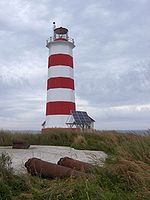 Sambro Island Lighthouse, built in 1758, the oldest surviving lighthouse in North America
Sambro Island Lighthouse, built in 1758, the oldest surviving lighthouse in North America
Ethnic Origin Population % of Total[15] Canadian 139,035 37.7 English 126,210 34.2 Scottish 110,065 29.8 Irish 90,650 24.5 French 66,400 18.0 German 44,615 12.1 Dutch 14,640 4.0 North American Indian 12,650 3.4 Welsh 8,220 2.2 British Isles, not included elsewhere 7,045 1.9 Italian 6,700 1.8 Polish 5,375 1.5 Acadian 5,270 1.4 Ukrainian 4,030 1.1 Lebanese 3,895 1.1 Chinese 3,720 1.0 African, not included elsewhere 3,480 0.9 Black 3,205 0.8 Religious belief
Breakdown:[16]
- 84.80%: Christian
- 12.90%: none
- 0.86%: Muslim
- 0.44%: Jewish
- 0.42%: Buddhist
- 0.27%: Hindu
- 0.05%: Sikh
- 0.10%: other Eastern religions
- 0.17%: other religions
Economy
Headquarters of Air Canada Jazz Main article: Economy of the Halifax Regional Municipality
Main article: Economy of the Halifax Regional MunicipalityThe urban area of Halifax Regional Municipality is a major economic centre in eastern Canada with a large concentration of government services and private sector companies. Halifax serves as the business, banking, government and cultural centre for the Maritime region. Major employers and economic generators include the Department of National Defence, as well as the Port of Halifax. The municipality has a growing concentration of manufacturing industries and is becoming a major multi-modal transportation hub through growth at the port, the Halifax Stanfield International Airport, and improving rail and highway connections. A real estate boom in recent years has led to numerous new property developments, including the gentrification of some former working-class areas.
Agriculture, fishing, mining, forestry and natural gas extraction are major resource industries found in the rural areas of HRM. HRM's largest agricultural district is in the Musquodoboit Valley; the total number of farms in HRM is 150, of which 110 are family-owned. Fishing harbours are located along all coastal areas with some having an independent harbour authority, and others being managed as small craft harbours under the federal Department of Fisheries and Oceans.
Other resource industries in HRM include the natural gas fields off the coast of Sable Island, as well as clay, shale, gold, limestone, and gypsum extraction in rural areas of the mainland portion of the municipality.
Government
Main article: Government in the Halifax Regional MunicipalityThe Halifax Regional Municipality is governed by a mayor (elected at large) and a twenty-three person council, who are elected by geographic district; municipal elections occur every four years. HRM has established community councils where three or more councillors agree to form these councils to deal primarily with local development issues. Most community council decisions are subject to final approval by regional council. The current Mayor of the Halifax Regional Municipality is Peter J. Kelly.
The Halifax Regional Council is responsible for all facets of municipal government, including the Halifax Regional Police, Halifax Public Libraries, Halifax Fire and Emergency, Halifax Regional Water Commission, parks and recreation, civic addressing, public works, waste management, and planning and development.
Education
Main article: Education in the Halifax Regional MunicipalityThe Halifax Regional Municipality has a well-developed network of public and private schools, providing instruction from primary to grade twelve; one hundred and thirty seven public schools are administered by the Halifax Regional School Board, as well as four public schools administered by the Conseil Scolaire Acadien Provincial, whereas the fourteen private schools are operated independently.
The municipality is also home to the following post-secondary educational institutions: Dalhousie University, Saint Mary's University, Mount Saint Vincent University, the Halifax campus of Université Sainte-Anne, University of King's College, Atlantic School of Theology, NSCAD University, the Centre for Arts and Technology, and the Nova Scotia Community College. The presence of so many university and college students contributes to a vibrant youth culture in the region, as well as making it a major centre for university education in eastern Canada.
Culture
Main article: Culture of the Halifax Regional Municipality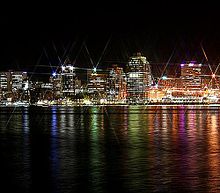 City Centre of Halifax at night
City Centre of Halifax at night
The urban area of Halifax Regional Municipality is a major cultural centre within the Atlantic provinces. The municipality's urban core also benefits from a large population of post-secondary students who strongly influence the local cultural scene. HRM has a number of art galleries, theatres and museums, as well as most of the region's national-quality sports and entertainment facilities. The municipality is home to many performance venues, namely the Rebecca Cohn Auditorium, the Neptune Theatre, and The Music Room. HRM also is the home to many of the region's major cultural attractions, such as Symphony Nova Scotia, the Art Gallery of Nova Scotia, The Khyber ICA, the Maritime Museum of the Atlantic and the Neptune Theatre. On special occasions, the city will put on a fireworks display which is best viewed from a boat. The region is noted for the strength of its music scene and nightlife, especially in the central urban core. See List of musical groups from Halifax, Nova Scotia for a partial list.
HRM plays host to a wide variety of festivals that take place throughout the year, including: The Atlantic Film Festival, The Royal Nova Scotia International Tattoo, The Halifax Busker Festival, Greekfest, The Atlantic Jazz Festival, The Multicultural Festival, The largest Canada Day celebration east of Ottawa, Natal Day, periodic Tall Ship events, and Shakespeare by the Sea, to name a few. Many of these celebrations have become world renowned over the past several years.
HRM has also become a significant film-production centre, with many American and Canadian filmmakers using the streetscapes, often to stand in for other cities that are more expensive to work in. The Canadian Broadcasting Corporation has its Atlantic Canada production centres (radio and television) based in Halifax, and quite a number of radio and television programs are made in the region for national broadcast.
HRM is considered by many to be the cultural centre of the Maritimes. The municipality has been able to maintain many of its maritime and military traditions, while opening itself to a growing multicultural population.
Sport
Main article: Sport in the Halifax Regional Municipality Halifax from the Angus L. MacDonald Bridge
Halifax from the Angus L. MacDonald Bridge
The Halifax Regional Municipality is home to a number of outdoor recreational opportunities, including numerous ocean and lake beaches, as well as rural and urban parks. The municipality has a host of organised community intramural sports, as well as varsity and intramural sports offered by public schools and post-secondary institutions and has extensive facilities.
The region is home to several semi-professional sport franchises, such as the Halifax Mooseheads of the Quebec Major Junior Hockey League (see also Sports teams in the Halifax Regional Municipality).
The region has also hosted several major sporting events, including the 2003 World Junior Hockey Championship, 2003 Nokia Brier, the 2004 Women's World Ice Hockey Championships, and 2007 World Indoor Lacrosse Championship. From 1984 to 2007, the region had been home to the CIS Men's Basketball Championship, however the tournament was moved to Ottawa, Ontario starting in 2008. The 72nd Ice Hockey World Championship was held between May 2 and May 18, 2008, in Halifax, Nova Scotia and Quebec City, Canada.
Halifax was selected as Canada's bid for the 2014 Commonwealth Games in 2006 but withdrew from the international competition in advance of the November 9, 2007 selection date on March 8.
In February 2011, the municipality hosted the 2011 Canada Winter Games.
Media
Main article: Media in the Halifax Regional MunicipalityHRM is the Maritimes' centre for broadcast and print media. CBC Television, CTV Television Network (CTV), and Global Television Network all have regional television hubs in the municipality. CBC Radio has a major regional studio and there are also regional hubs for Rogers Radio and various private broadcast franchises, as well as a regional bureau for The Canadian Press/Broadcast News.
HRM's print media is centred on its single daily newspaper, the broadsheet Halifax Chronicle-Herald as well as two free newspapers, the daily commuter-oriented edition of Metro International and the free alternative arts weekly The Coast. Frank provides HRM with a bi-weekly satirical and gossip magazine.
From 1974-2008, HRM had a second daily newspaper, the tabloid The Daily News which still publishes several neighbourhood weekly papers such as The Bedford-Sackville Weekly News, The Halifax West-Clayton Park Weekly News and the Dartmouth-Cole Harbour Weekly News. These weekly papers compete with The Chronicle-Herald's weekly Community Heralds HRM West, HRM East, and HRM North.
Transportation
Main article: Transportation in the Halifax Regional Municipality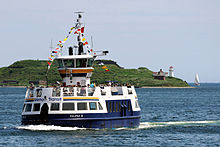 Metro Transit ferry crossing the harbour
Metro Transit ferry crossing the harbour
Halifax Harbour is a major port used by numerous shipping lines, administered by the Halifax Port Authority. The navy and coast guard have major installations along prominent sections of coastline in both Halifax and Dartmouth. The harbour is also home to a public ferry service connecting downtown Halifax to two locations in Dartmouth. Sheet Harbour is the other major port in the municipality and serves industrial shippers on the Eastern Shore.
The Halifax Port Authority's various shipping terminals constitute the eastern terminus of Canadian National Railway's transcontinental network. Via Rail Canada provides overnight passenger rail service from the Halifax Railway Station six days a week to Montreal with the Ocean, a train equipped with sleeper cars that stops in major centres along the way, such as Moncton. The Halifax Railway Station also serves as the terminus for Acadian Lines intercity buses which serve destinations across Atlantic Canada.
Halifax Stanfield International Airport serves HRM and most of the province, providing scheduled flights to domestic and international destinations. CFB Shearwater, an air force base, is located on the eastern side of Halifax Harbour.
The municipality's urban core is linked by the Angus L. Macdonald and A. Murray MacKay suspension bridges, as well as the network of 100-series highways which function as expressways. The Armdale traffic circle is an infamous choke point for vehicle movement in the western part of the urban core, especially at rush hour.
The urban core of HRM is served by Metro Transit, which operates standard bus routes, bus-rapid transit routes, as well as the pedestrian-only harbour ferries. Established in 1752 , the municipality's ferry service is the oldest continuously running salt water ferry service in North America.[17]
-
Driving in the Halifax Urban Area during winter on Windmill Road in Dartmouth. Cars heading toward the MacKay Bridge.
Architecture
Further information: Buildings and structures in the Halifax Regional Municipality Purdy's Wharf towers in Downtown Halifax
Purdy's Wharf towers in Downtown Halifax
10 Tallest Buildings in Halifax Name Height Floors Fenwick Tower 322 feet (98 m) 32 Purdy's Wharf Tower 2 289 feet (88 m) 22 1801 Hollis Street 285 feet (87 m) 22 Barrington Tower 276 feet (84 m) 20 Cogswell Tower 259 feet (79 m) 20 Maritime Centre 256 feet (78 m) 21 Queen Square 246 feet (75 m) 19 Purdy's Wharf Tower 1 243 feet (74 m) 18 Bank of Montreal Building 240 feet (73 m) 18 TD Tower 240 feet (73 m) 18 HRM's urban core is home to a number of regional landmark buildings and retains some significant historic buildings. The downtown's mid level office towers are overlooked by the fortress of Citadel Hill with its iconic Halifax Town Clock.
The architecture of Halifax's South End is renowned for its grand Victorian houses while the West End and North End, Halifax have many blocks of well preserved wooden residential houses with notable features such as the "Halifax Porch". Dalhousie University's campus is often featured in films and documentaries. Dartmouth also has its share of historic neighbourhoods.
The urban core is home to several blocks of typical North American high-rise office buildings, however segments of the downtown is governed by height restrictions which prevent buildings from obstructing certain sight lines between Citadel Hill and Halifax Harbour. This has resulted in some modern high rises being built at unusual angles or locations.
In recent decades there has been a good deal of conflict between those in favour of modern development and heritage preservationists. The former has been occasionally seen as threatening the historic character of certain areas of the city, while the latter has been accused of stifling growth in the city and contributing to the economic stagnation of certain districts. Much municipal consultation in recent years, such as the HRM by Design project, has focused on how to allow modernization and development to encourage repatriation and renewed community diversification, while preserving the remaining heritage structures and character.
Sister cities
 Hakodate, Japan (1982). The cities chose to twin because they both have star forts.[18]
Hakodate, Japan (1982). The cities chose to twin because they both have star forts.[18] Campeche, Mexico (1999). Campeche was chosen because, like Halifax, it is "a capital of a state" and is "a city of similar size to Halifax on or near the coast having rich historical tradition".[19]
Campeche, Mexico (1999). Campeche was chosen because, like Halifax, it is "a capital of a state" and is "a city of similar size to Halifax on or near the coast having rich historical tradition".[19] Norfolk, Virginia (2006). Norfolk was chosen because, like Halifax, its economy "depends heavily on the presence of the Armed Forces, and both cities are very proud of their military history".[20]
Norfolk, Virginia (2006). Norfolk was chosen because, like Halifax, its economy "depends heavily on the presence of the Armed Forces, and both cities are very proud of their military history".[20]
Major parks
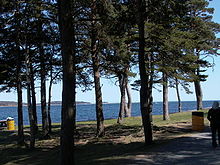 Point Pleasant Park, a popular forested seaside park on peninsular Halifax.
Point Pleasant Park, a popular forested seaside park on peninsular Halifax. Main article: List of parks in the Halifax Regional Municipality
Main article: List of parks in the Halifax Regional Municipality- Dartmouth Commons
- Halifax Citadel National Historic Site
- Halifax Commons
- Point Pleasant Park
- Public Gardens
- Shubie Park
- Sir Sandford Fleming Park
- York Redoubt National Historic Site
- Long Lake Provincial Park
Notable Haligonians
Main article: List of people from Halifax Regional Municipality- Chögyam Trungpa—founder of Vajradhatu and Shambhala Buddhism
- Sidney Crosby—Professional ice hockey player for the Pittsburgh Penguins
- Sir Samuel Cunard—British shipping magnate
- Denny Doherty—Founding member of the 1960s musical group The Mamas & the Papas
- Joseph Howe—politician, oversaw the formation of the first responsible government in a British colony
- Sarah Jeanette Jackson—digital artist
- Colleen Jones—Most successful Canadian women's skip in curling history
- Alexander Keith—Fourth Mayor of Halifax and founder of the Alexander Keith's brewing company
- Robert MacNeil—Journalist and television announcer
- Garrett Mason—Musician
- Alexa McDonough—former federal leader of the New Democratic Party. Also interim President and Vice-Chancellor of Mount Saint Vincent University
- Sarah McLachlan—Singer and songwriter
- Ellen Page—Academy Award nominated actress
- Joel Plaskett— Singer/songwriter
- Sloan—alternative pop/rock quartet
- Sir John Thompson—4th Prime Minister of Canada
- Sir Charles Tupper—6th Prime Minister of Canada
- Sakyong Mipham—Head of Shambhala Buddhism
See also
- Halifax Regional Municipality municipal election, 2008
- Halifax Harbour
- Halifax Port Authority
- Halifax Explosion
- Halifax Regional Fire and Emergency
- Halifax Regional Police
- Halifax Regional Water Commission
- Bedford Institute of Oceanography
References
- ^ a b c "2006 Statistics Canada Community Profile: Halifax Regional Municipality, Nova Scotia". 2.statcan.ca. 2010-12-07. http://www12.statcan.ca/census-recensement/2006/dp-pd/prof/92-591/details/page.cfm?Lang=E&Geo1=CSD&Code1=1209034&Geo2=PR&Code2=13&Data=Count&SearchText=halifax&SearchType=Begins&SearchPR=01&B1=Custom&Custom=1000,7000,8000. Retrieved 2011-04-08.
- ^ "2006 Community Profile for HRM". 2.statcan.ca. 2010-12-07. http://www12.statcan.ca/english/census06/data/profiles/community/Details/Page.cfm?Lang=E&Geo1=CSD&Code1=1209034&Geo2=PR&Code2=12&Data=Count&SearchText=Halifax&SearchType=Begins&SearchPR=12&B1=All&Custom=. Retrieved 2011-04-08.
- ^ "Census metropolitan area (CMA) and census agglomeration (CA) - plain language definition, 2006 census". Geodepot.statcan.ca. 2007-04-23. http://geodepot.statcan.ca/2006/180506051805140305/03150707/19081518200405190318091620091514_05-eng.jsp?GEO_LEVEL=5&ABBRV=null&REFCODE=10&LANG=E&TYPE=L. Retrieved 2011-04-08.
- ^ "Population of census metropolitan areas (2006 Census boundaries)". Statistics Canada. 2010-02-04. http://www.statcan.gc.ca/pub/91-214-x/2009000/t013-eng.htm. Retrieved 2010-03-13.
- ^ a b "Population and dwelling counts, for Canada, provinces and territories, and urban areas, 2006 and 2001 censuses - 100% data". 2.statcan.ca. 2008-11-05. http://www12.statcan.ca/english/census06/data/popdwell/Table.cfm?T=802&PR=12&S=0&O=A&RPP=25. Retrieved 2011-04-08.
- ^ [1][dead link]
- ^ "HRM - Traffic and Transportation - Urban Core Boundaries". Halifax.ca. 2009-01-27. http://www.halifax.ca/Works/Streets/regionboundary.html. Retrieved 2011-04-08.
- ^ "2001 Community Profiles". 2.statcan.ca. 2002-03-12. http://www12.statcan.ca/english/profil01/CP01/Details/Page.cfm?Lang=E&Geo1=CSD&Code1=1209022&Geo2=PR&Code2=12&Data=Count&SearchText=dartmouth&SearchType=Begins&SearchPR=12&B1=All&Custom=. Retrieved 2011-04-08.
- ^ "HRM - Regional Planning". Halifax.ca. 2006-08-25. http://halifax.ca/regionalplanning/Region/region.html. Retrieved 2011-04-08.
- ^ "HRM - Planning". Halifax.ca. 2011-03-30. http://www.halifax.ca/planning/map.html. Retrieved 2011-04-08.
- ^ http://halifax.ca/civicaddress/documents/HRMstreetlist.pdf
- ^ "Canadian Climate Normals 1971−2000: Canada's National Climate Archive". http://www.climate.weatheroffice.ec.gc.ca/climate_normals/results_e.html?Province=ALL&StationName=Halifax&SearchType=BeginsWith&LocateBy=Province&Proximity=25&ProximityFrom=City&StationNumber=&IDType=MSC&CityName=&ParkName=&LatitudeDegrees=&LatitudeMinutes=&LongitudeDegrees=&LongitudeMinutes=&NormalsClass=A&SelNormals=&StnId=6357&. Retrieved 2008−07−16.
- ^ "Halifax Chamber of Commerce | Home". Halifaxchamber.com. http://www.halifaxchamber.com/. Retrieved 2011-04-08.
- ^ Statistics Canada: 1996, 2001, 2006 census
- ^ "Ethnocultural Portrait of Canada Highlight Tables, 2006 Census". 2.statcan.ca. 2010-10-06. http://www12.statcan.ca/english/census06/data/highlights/ethnic/pages/Page.cfm?Lang=E&Geo=CSD&Code=1209034&Data=Count&Table=2&StartRec=1&Sort=3&Display=All&CSDFilter=5000. Retrieved 2011-04-08.
- ^ "2001 Community Profiles". 2.statcan.ca. 2002-03-12. http://www12.statcan.ca/english/Profil01/CP01/Details/Page.cfm?Lang=E&Geo1=CSD&Code1=1209034&Geo2=PR&Code2=12&Data=Count&SearchText=halifax&SearchType=Begins&SearchPR=01&B1=All&Custom=. Retrieved 2011-04-08.
- ^ "HRM - History - Main". Halifax.ca. http://www.halifax.ca/community/history.html. Retrieved 2011-04-08.
- ^ "July 4, 2000 - HRM Media Room Press Releases 2000". Halifax.ca. http://www.halifax.ca/mediaroom/pressrelease/pr2000/000704fortressconf.html. Retrieved 2011-04-08.
- ^ http://www.halifax.ca/council/Minutes/1998/c980113.pdf
- ^ "HRM to Twin with Norfolk, Virginia". Halifax.ca. 2006-08-25. http://www.halifax.ca/mediaroom/pressrelease/pr2006/060426HRMtoTwinwithNorfolkVirginia.html. Retrieved 2011-04-08.
External links
- Halifax Regional Municipality
- Greater Halifax Partnership
- Halifax Webcams
- Guide to Halifax
- Photographs of historic monuments in Halifax Regional Municipality
- Flags of Halifax and Halifax Regional Municipality
- HRM: District 2 News
- Halifax Trails

Hants County / Colchester County 
Lunenburg County 
Guysborough County  Halifax Regional Municipality
Halifax Regional Municipality 

Atlantic Ocean Categories:- Halifax Regional Municipality
- Geographic regions of Nova Scotia
- Municipalities of Nova Scotia
- Populated coastal places in Canada
- Populated places established in 1996
- Port settlements in Canada
Wikimedia Foundation. 2010.


